
Muslim rule in the Indian subcontinent began in the course of a gradual Muslim conquest in the Indian subcontinent, beginning mainly after the conquest of Sindh and Multan led by Muhammad bin Qasim. Following the perfunctory rule by the Ghaznavids in Punjab, Sultan Muhammad of Ghor is generally credited with laying the foundation of Muslim rule in Northern India.
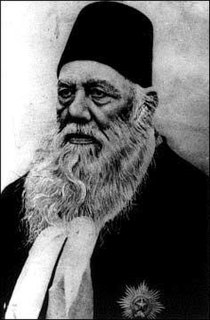
Sir Syed Ahmad Taqvi bin Syed Muhammad Muttaqi KCSI, commonly known as Sir Syed Ahmad Khan, was an Islamic pragmatist, Islamic reformer, philosopher, and educationist in nineteenth-century British India. Though initially espousing Hindu-Muslim unity, he became the pioneer of Muslim nationalism in India and is widely credited as the father of Two-Nation Theory which formed the basis of Pakistan movement. Born into a family with strong debts to the Mughal court, Ahmad studied the Quran and Sciences within the court. He was awarded an honorary LLD from the University of Edinburgh in 1889.

Nawab also spelt Nawaab, Navaab, Navab, Nowab, Nabob, Nawaabshah, Nawabshah or Nobab, is a Royal title indicating a sovereign ruler, often of a South Asian state, in many ways comparable to the western titles of King. The relationship of a Nawab to the Emperor of India has been compared to that of the Kings of Saxony to the German Emperor. In earlier times the title was ratified and bestowed by the reigning Mughal emperor to semi-autonomous Muslim rulers of subdivisions or princely states in the Indian subcontinent loyal to the Mughal Empire i.e. Nawabs of Bengal. The title is common among Muslim rulers of South Asia as an equivalent to the title Maharaja, however it is not exclusive to Muslims only.
Urdu literature is literature in the Urdu language. While it tends to be dominated by poetry, especially the verse forms of the ghazal غزل and nazm نظم, it has expanded into other styles of writing, including that of the short story, or afsana افسانہ. Urdu literature is mostly popular in Pakistan, where Urdu is the national language and India, where it is a recognized language. It is also widely understood in Afghanistan and has moderate amount of popularity in Bangladesh.

Islam is the second-largest religion in India, with 14.2% of the country's population, approximately 172.2 million people, identifying as adherents of Islam in the 2011 census. It makes India the country with the largest Muslim population outside Muslim-majority countries. The majority of Indian Muslims belong to Sunni sect of Islam while the Shia form a sizeable minority.
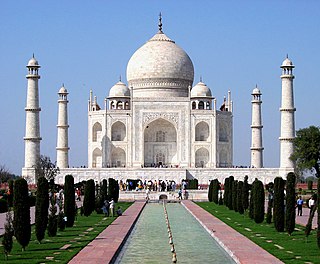
Indo-Persian culture refers to a cultural synthesis present in the Indian subcontinent, characterized by the absorption or integration of Persian aspects into the various cultures of Pakistan, India and Bangladesh. The first large-scale introduction of Persian influence and culture to the Indian subcontinent was by Muslim rulers of Turkic and Afghan origin with Persianate societies and Persianized cultures. This socio-cultural synthesis arose steadily through the Delhi Sultanate from the 13th to 16th centuries, and the Mughal Empire from then onwards until the 19th century. Various Muslim Turko-Persian rulers, such as the 11th-century Sultan Mahmud Ghaznavi, rapidly pushed for the heavy Persianization of conquered territories in northwestern India, where Islamic influence was also firmly established.
Ahmed Ali was a Pakistani novelist, poet, critic, translator, diplomat and scholar. A pioneer of the modem Urdu short story, his works include the short story collections: Angarey (Embers), 1932; Hamari Gali, 1940; Qaid Khana, 1942; and Maut Se Pehle, 1945. His other writings include Twilight in Delhi (1940), his first novel in the English language.
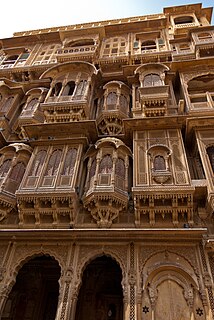
A haveli is a traditional townhouse or mansion in the Indian subcontinent, usually one with historical and architectural significance. The word haveli is derived from Arabic hawali, meaning "partition" or "private space", popularised under the Mughal Empire, and was devoid of any architectural affiliations. Later, the word haveli came to be used as a generic term for various styles of regional mansions, townhouse and temples found in the Indian subcontinent.
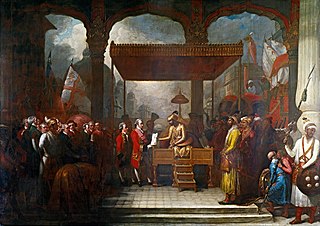
Shah Alam II, born as Ali Gohar or Ali Gauhar, was the eighteenth Mughal Emperor and the son of Alamgir II. Shah Alam II became the emperor of a crumbling Mughal empire. His power was so depleted during his reign that it led to a saying in the Persian language, Sultanat-e-Shah Alam, Az Dilli ta Palam, meaning, 'The empire of Shah Alam is from Delhi to Palam', Palam being a suburb of Delhi.

Mir Muhammad Taqi Mir, also known as Mir Taqi Mir or Meer Taqi Meer, was an Urdu poet of the 18th century Mughal India, and one of the pioneers who gave shape to the Urdu language itself. He was one of the principal poets of the Delhi School of the Urdu ghazal and is often remembered as one of the best poets of the Urdu language. His takhallus was Mir. He spent the latter part of his life in the court of Asaf-ud-Daulah in Lucknow.
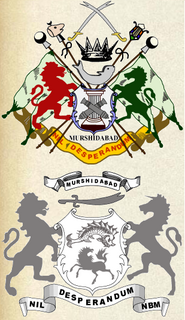
The Nawab of Bengal was the hereditary ruler of Bengal Subah in Mughal India. The Nawab of a princely state or autonomous province is comparable to the European title of Grand Duke. In the early 18th-century, the Nawab of Bengal was the de facto independent ruler of the three regions of Bengal, Bihar, and Orissa which constitute the modern-day sovereign country of Bangladesh and the Indian states of West Bengal, Bihar and Orissa. They are often referred to as the Nawab of Bengal, Bihar and Orissa. The Nawabs were based in Murshidabad which was centrally located within Bengal, Bihar, and Orissa. Their chief deputy was the Naib Nazim of Dhaka.

Shah Abdul Latif Bhittai, commonly known by the honorifics Lakhino Latif, Latif Ghot, Bhittai, and Bhit Jo Shah, was a Sindhi philosopher, Sufi mystic, and poet, widely considered to be the greatest poet of the Sindhi language.
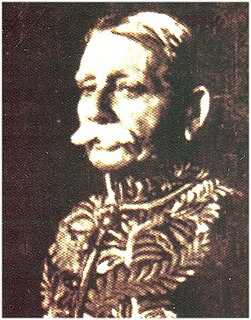
Syed Ameer Ali Order of the Star of India (1849–1928) was an Indian/British Indian jurist hailing from the state of Oudh from where his father moved and settled down at Bengal Presidency. He was a prominent political leader, and author of a number of influential books on Muslim history and the modern development of Islam, who is credited for his contributions to the Law of India, particularly Muslim Personal Law, as well as the development of political philosophy for Muslims, during the British Raj. He was a signatory to the 1906 Petition to the Viceroy and was thus a founding-member of the All India Muslim League.

The Asaf Jahi was a dynasty which ruled the Kingdom of Hyderabad. The family came to India in the late 17th century, and became employees of the Mughal Empire. As the Mughals, of Turco-Mongol origin, were great patrons of Persian culture, language, and literature, the family found a ready patronage.
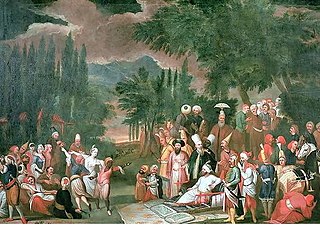
History of the Turkic peoples between 6th and 14th centuries. Although the chronology of the Seljuq Sultanate of Rûm is covered in this timeline, for a more detailed timeline for the Seljuq Sultanate of Rûm see Timeline of the Seljuq Sultanate of Rûm. For a timeline of the modern Turkish state and its legal predecessor see Timeline of the Ottoman Empire and Timeline of Turkish history. Beyond what is described in this timeline, Turkic peoples have lived outside of the Ottoman Empire and Turkey, such as in Azerbaijan and the Central Asian republics of former USSR as well as Russia, China, Iran, Afghanistan, Pakistan & India.

The Turk Jamat are a Muslim community found in India. Many members of Turk Jamat Muslim community migrated to Pakistan after the independence in 1947 and settled in Karachi.
The Persian language in the Indian subcontinent, before the British colonization, was the region's lingua franca and a widely used official language in north India. The language was brought into South Asia by various Turkic and Afghan dynasties, in particular the Turko-Afghan Ghurid Dynasty, Delhi Sultanate and the Mughal Dynasty. Persian held official status in the court and the administration within these empires and it heavily influenced many of the local indigenous languages, particularly Hindi and Urdu.

Bengali Muslims are an ethnic, linguistic and religious population who make up the majority of Bangladesh's citizens and the largest minority in the Indian states of West Bengal and Assam. They are Bengalis who adhere to Islam and speak the Bengali language. They form the largest Bengali and the second largest Muslim ethnic group in the world.
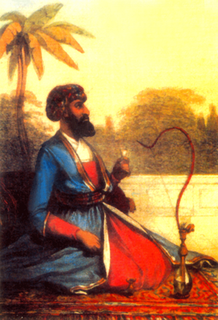
Mīrzā Muḥammad I'tiṣām al-Dīn Panchnūrī, or Itesham Uddin, was a Mughal Empire diplomat and the first educated Indian and Bengali to travel to Europe, in 1765. He was also a munshi serving the Nawabs of Bengal as well as the East India Company. He had also written the text of the 1765 Treaty of Allahabad.
Turkic peoples have historically been associated as one of the non-indigenous peoples to have ruled areas of the Indian subcontinent. Modern day Turkish people in India, on the other hand, are very small in number, and are recent immigrants from Turkey. In the 1961 census, 58 people stated that their mother tongue was Turkish. According to the 2001 census, 126 residents of India stated their place of birth as Turkey. In a state visit during early 2010, Prime Minister Abdullah Gül of Turkey met Turkish expatriates living in India and handed out Hindi-Turkish dictionaries to Turkish students in New Delhi.














